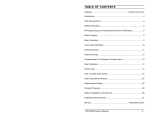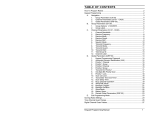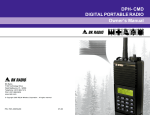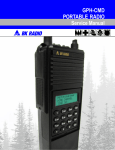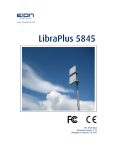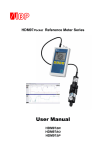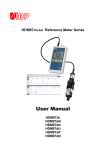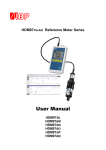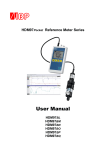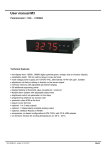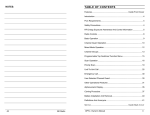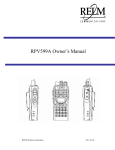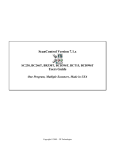Download BK Radio KNG M-400 Specifications
Transcript
KNG Editor Help RELM Wireless Corporation Technical Support Department 7100 Technolgy Drive West Melbourne, FL 32904 (800) 422-6281 www.relm.com © 2008 RELM Wireless Corporation 66 KNG Editor Help Contents ............................................. 49 Mixed-Mode Talkback ............................................. 16 Selectable Tone ............................................. 30 Serial Number -N- ............................................. 62 SLN Squelch ............................................. 19 ............................................. 22 Sw ............................................. 55 Switch Assignments ............................................. 13, 17, 60 NAC 58 NAC Pick............................................. List ............................................. 21 Narrow Band 48 Nuisance............................................. Channel Delete ............................................. 35 Null Frequency -OOTAR............................................. 24, 62 -P............................................. 31, 51 P25 ID 31 P25 Unit ............................................. ID 51 P25 Unit ............................................. IDs ............................................. 31, 33, 48 Password ............................................. 49 Per-Channel Low Power ............................................. 60, 61 Pick List 59 Pick Lists............................................. Tab ............................................. 40 Power Setting Priority 1 ............................................. 27 Priority 2 ............................................. 27 ............................................. 27 Priority Options ............................................. 48 Priority Scan Period ............................................. 27 Priority Transmissions -R- Table of Contents Part I Overview 5 Part II Channel & Zone Settings 8 1 Channel Settings ............................................................................................. 9 -T- ............................................. 19 Talk Group Talkback............................................. 49 49 Talkback............................................. Scan ............................................. 58 TGID Pick List 49 Transmit ............................................. Features 14 Transmit ............................................. Frequency 15 Transmit ............................................. Mode ............................................. 36 TX Timeout-Timer -U............................................. 49 Unit-to-Unit Callback ............................................. 31 User Password ............................................. 19 User Selectable Talk Group 61 User Talk............................................. Group ............................................. 60 User Tx Guard ............................................. 60 User Tx NAC UTGID ............................................. 61 UTXG ............................................. 60 -W- ............................................. 48 Radio Features ............................................. 10 Receive Frequency ............................................. 21 Wide Band ............................................. 11 Receive Mode -Z- -S- ............................................. 25 Zone Label ............................................. 28 Zone Scan List ............................................. 25 Zone Settings ............................................. 21 Scan ............................................. 41 Scan Hold Time ............................................. 21 Scan Mode ............................................. 22, 62 Security 3 Label ................................................................................................................. 10 ................................................................................................................. 10 Receive Frequency ................................................................................................................. 11 Receive Mode ................................................................................................................. 12 Receive Code Guard Receive NAC................................................................................................................. 13 ................................................................................................................. 14 Transmit Frequency ................................................................................................................. 15 Transmit Mode ................................................................................................................. 16 Transmit Code Guard ................................................................................................................. 17 Transmit NAC ................................................................................................................. 19 Squelch Operation Talk Group ................................................................................................................. 19 ................................................................................................................. 21 Scan Bandwidth ................................................................................................................. 21 ................................................................................................................. 22 Low Power per Channel ................................................................................................................. 22 Security ................................................................................................................. 23 Key Key Lock ................................................................................................................. 24 ................................................................................................................. 24 OTAR 2 Zone Settings ............................................................................................. 25 Identification ................................................................................................................. 25 ................................................................................................................. 27 Priority Options ................................................................................................................. 28 Other Options Part III Global Settings 29 1 General Tab ............................................................................................. 30 ............................................. 17 Selectable NAC KNG Editor Help General Settings ................................................................................................................. 30 Embedded Serial Number ...................................................................................... 30 ...................................................................................... 31 P25 Unit ID ...................................................................................... 31 User Password Administrator Password ...................................................................................... 33 Null Frequency Substitution...................................................................................... 35 ...................................................................................... 36 TX Timeout-Timer ...................................................................................... 37 Battery Saver © 2008 RELM Wireless Corporation Index KNG Editor Help 4 Busy Channel Mode Power setting Scan Hold Time ...................................................................................... 38 ...................................................................................... 40 ...................................................................................... 41 Global Priority ................................................................................................................. 41 Priority 1 ...................................................................................... 42 ...................................................................................... 42 Priority 2 ANI/DTMF ................................................................................................................. 43 DTMF Deviation ...................................................................................... 43 ...................................................................................... 44 ANI Rate ...................................................................................... 44 Front Porch Time Emergency Tx ................................................................................................................. 45 ................................................................................................................. 46 Backlight Settings ................................................................................................................. 47 Display 2 Features Tab ............................................................................................. 48 Radio Features ................................................................................................................. 48 ................................................................................................................. 49 Transmit Features 3 Individual Call ............................................................................................. List Tab 51 ............................................................................................. 52 4 Keypad Editing Lockouts Tab ............................................................................................. 54 5 Menus & Controls Tab Switch Assignments ................................................................................................................. 55 ................................................................................................................. 56 Button Assignments ................................................................................................................. 58 Programming 6 Pick Lists Tab ............................................................................................. 59 User Tx Guard ................................................................................................................. 60 User Tx NAC................................................................................................................. 60 ................................................................................................................. 61 User Talk Group 7 Encryption............................................................................................. Tab 62 Part IV Tuning 63 1 TX Power ............................................................................................. 63 2 TX Frequency ............................................................................................. 64 ............................................................................................. 64 3 TX Analog Deviation Index -A............................................. 33 Administrator Password ............................................. 23 AES ............................................. 44 ANI Rate............................................. 44 ANI ............................................. 25, 43 ANI/DTMF 25 Automatic............................................. Number Identification -B- 46 Backlight............................................. Settings ............................................. 21 Bandwidth ............................................. 37 Battery Saver ............................................. 38 Busy Channel ............................................. 56 Button Assignments -C- Call List ............................................. 58 Callback ............................................. 49 8 Channel &............................................. Zone Settings ............................................. 9 Channel Settings ............................................. 22 Clr 12, 16 Code............................................. Guard ............................................. 58 CxCSS Pick List -D- ............................................. 23 DES Display ............................................. 47 ............................................. 47 Display Options ............................................. 43 DTMF Deviation ............................................................................................. 64 4 TX Digital Deviation ............................................................................................. 64 5 Receiver Front End -E- 6 Squelch Adjustment ............................................................................................. 64 ............................................. 45 Emergency ............................................. 45 Emergency operation Index 65 KNG Editor Help ............................................. 22 ............................................. 48, 62 Encryption Enc © 2008 RELM Wireless Corporation 65 ............................................. 62 Encryption Tab -F48 Features ............................................. Tab ............................................. 10, 14 Frequency ............................................. 44 Front Porch Time -G- ............................................. 30 General Settings ............................................. 30 General Tab ............................................. 41 Global Priority ............................................. 42 Global Priority 1 ............................................. 42 Global Priority 2 ............................................. 29 Global Settings -H............................................. 41 Hold Time -I28 Incoming............................................. Clone 51 Individual............................................. Call List Tab -KKey Lock............................................. 24 24 Key Pick ............................................. List Keypad ............................................. 58 ............................................. 52 Keypad Editing Lockouts ............................................. 58 Keypad Programming Menu -L............................................. 10 Lockout ............................................. 38 ............................................. 38 Lockout with Override Label ............................................. 22 Low Power -M54 Menus & ............................................. Controls Tab 64 KNG Editor Help Overview TX Frequency 5 1 Overview TUNING HELP UNDER CONSTRUCTION KNG Editor is the PC Programming Software for BK Radio's KNG APCO Project 25 digital portable radio. To meet backwards compatibility as defined by the APCO Project 25 standard, the KNG provides users the ability to interoperate with narrow or wide band analog channels as well as digital systems. TX Analog Deviation TUNING HELP UNDER CONSTRUCTION Select Radio Type The KNG Programming Software is designed to program multiple model types.Use the dropbox to select the model type of the radios you will be programming. TX Digital Deviation Model Types TUNING HELP UNDER CONSTRUCTION P150 Portable VHF P400 Portable UHF - Low P500 Portable UHF - High P800 Portable 800 MHz M150Mobile VHF M400Mobile UHF Low M500Mobile UHF High Mobile 800 M800 MHz Receiver Front End TUNING HELP UNDER CONSTRUCTION Squelch Adjustment TUNING HELP UNDER CONSTRUCTION Channel Zones Radio channels can be separated into zones. Each zone of channels has its own Channel Screen and Zone Settings Screen. KNG Editor Help © 2008 RELM Wireless Corporation 6 KNG Editor Help Global Settings 63 Security Enable Clear Tx Mode Warning Beep If checked, the radio emits an audible tone with each Push-to-Talk when encryption is disabled. If unchecked, no warning tone is heard prior to unencrypted transmissions. OTAR Radios that have the factory option support Over-the-Air Rekeying of encryption keys (OTAR). Channel Screen The Channel Screen allows editing of each channel's Frequencies, Operating Modes, Channel Guards, Network Access Codes (NAC), P25 Squelch Operation, Talk Group ID, Bandwidth (BW) Low Power lock (LP) and security selections. Each channel can also be added to or deleted from the zone's scan list (SCN). To access a Channel Screen, click on one of the Zone folders in the leftmost panel. If checked, Over-the-Air Rekeying is enabled. If uncheck, Over-the-Air Rekeying is disabled. Mark the OTAR channel(s) that will communicate with the Key Management Facility (KMF) in the Channels Screen. Zone Settings Screen The Zone Settings Screen allows editing of data that is specific to each Channel Zone, such as the Zone Label, Priority Channels, etc. To access a Zone Settings Screen, click on the '+' sign next to a Zone folder, then click on the Settings folder. When the radio is operating in Channel Scan, Priority Scan, and Zone Scan, the main zones's OTAR Scan Option Channel is used for the OTAR channel. If the OTAR Scan Option Channel is set to "None", OTAR will be disabled when any scan mode is enabled. 4 Tuning TUNING HELP UNDER CONSTRUCTION TX Power TUNING HELP UNDER CONSTRUCTION KNG Editor Help © 2008 RELM Wireless Corporation 62 KNG Editor Help Overview 7 Encryption Tab Radios with digital encryption options can hold up to 32 DES or AES encryption keys. Each channel is assigned a default Key for transmit. The key can be locked to the channel, or if programming allows, a transmit key other than the default key can be selected from the radio's Key Pick List. If a key is selected from the pick list, it will be used during transmit on every channel that allows selectable keys. A KVL 3000 Plus Keyloader (Available from Motorola) and Keyload Interface Cable are required to program encryption keys to the KNG. SLN Enter SLN's (Storage Location Numbers) in the table that correspond to the CKR's (Common Key References) of the keys that have been loaded into the radio with an APCO Project 25 compatible keyloader unit. Global Settings Screen The Global Settings Screen allows editing of data that will be used by ALL Channel Zones in the radio, such as the radio's P25 Unit ID, Talkback Modes, and Soft Switch assignments. To access the Global Settings Screen, click on Global Settings in the leftmost panel. Label Program an alphanumeric label for each active encryption key. Writing Data to Radio To write ALL data to the radio, click on the Write button. KNG Editor Help © 2008 RELM Wireless Corporation 8 KNG Editor Help Global Settings To write selected data to the radio, from the menu bar select "Write" to pull down the Write Menu. Hexadecimal 61 Decimal Reading Data from Radio To read ALL data from the radio, click on the Read button. To read selected data from the radio, from the menu bar select 'Read' to pull down the Read Menu. To assign a UNAC for use on a channel, the transmit NAC must be set to UNAC EN or UTXG xx, where "xx" = NAC. (See Transmit NAC ) User Talk Group To program the UTGID Pick List with this editor, click on the Global Settings icon on the left-most panel, then select the Pick Lists. Enter up to 32 TGIDs. 2 Channel & Zone Settings Channel Settings To assign a UTGID for use on a channel, the transmit code guard must be set to 0.0 or UTGID xx, where "xx" = selected talk group. (See Talk Group ) KNG Editor Help © 2008 RELM Wireless Corporation 60 KNG Editor Help Channel & Zone Settings User Tx Guard The UTXG Pick List feature allows users to choose CxCSS's from a separate (TX only) pick list containing 32 entries. To program the UTXG Pick List with this editor, click on the Global Settings icon on the left-most panel, then select the Pick Lists tab. Enter up to 32 Tone Guards or Digital Guards. Label Transmit Mode Bandwidth Receive Frequency Transmit Code Guard Low Power per Channel Receive Mode Transmit NAC Security Receive Code Guard Squelch Operation Key Receive NAC Talk Group Key Lock Transmit Frequency Scan OTAR Zone Settings To assign a UTXG for use on a channel, the transmit code guard must be set to 0.0 or UTXG xx, where "xx" = selected code guard. (See Transmit Code Guard ) Identification User Tx NAC To program the user selectable NAC Pick List with this editor, click on the Global Settings icon on the left-most panel, then select the Pick Lists tab. Enter up to 32 Network Access Codes. Channel Settings In hexadecimal mode, valid entries are $0 - $FFF. The values $F7E and $F7F are reserved for receivers and cannot be entered. To enter hexadecimal characters A - F. In Decimal Mode, valid entries are 0000 - 4095. The values 3966 and 3967 are reserved for receivers and cannot be entered. KNG Editor Help © 2008 RELM Wireless Corporation Priority Options Other Options 9 10 KNG Editor Help Global Settings 59 Drag and drop the desired operations from the Available box into the Used box. Label Transmit Mode Bandwidth Receive Frequency Transmit Code Guard Low Power per Channel Receive Mode Transmit NAC Security Receive Code Guard Squelch Operation Key Receive NAC Talk Group Key Lock Transmit Frequency Scan OTAR Label The radio can be programmed with a Label for each channe within a zone. Each label can include up to thirteen characters. Characters can include A–Z, 0–9, – , . , *, $, /, +, %, \, |, _, <, >, h, or a blank space. The order in which the items appear on the radio can be set by dragging and dropping the Used functions in the desired order. Programming Options Keypad Programmable Zone and Channel information (frequencies, modes, etc.)* Call List P25 ID number and label settings. NAC Pick List Network Access Codes available for user selection. Receive Frequency TGID Pick List Talk Groups available for user selection. CxCSS Pick List Code Guards available for user selection. * Individual settings can be blocked from keypad programming access with the PC Radio Editor. (See Keypad Programming Lockouts.) Enter a valid receive frequency. Pick Lists Tab Tx Code Guard Model Tx NAC Valid Frequency Range KNG Editor Help © 2008 RELM Wireless Corporation Tx Talk Group 58 KNG Editor Help Blank No option assigned Channel Scan Activate channel scan Priority Scan Activate priority scan Repeater Talkaround Channel & Zone Settings P150 136 to 174 MHz. P400 380 to 470 MHz Transmit on programmed receive frequency P500 440 to 520 MHz Zone Scan Activate Zone scanning P800 700 to 900 MHz Emergency Activate emergency function (Digital and Mixed Mode channels only) M150 136 to 174 MHz. Backlight Activate keypad/display lighting M400 380 to 470 MHz Tx Power Toggle High/Low transmit power M500 440 to 520 MHz Monitor Unmute audio M800 700 to 900 MHz Tx Digital Mode Toggle Digital/Analog transmitting (Mixed Mode channels only) Tx Secure Toggle between clear and encrypted transmission on channels programmed for switchable secure Tx. (See Zone settings) Individual Call Activate Unit-to-Unit Call mode Zeroize Keys Erase all encryption keys and passwords Request Key Request new encryption key. (OTAR enabled radios only ) PRI Chan Select Assign new Priority 1 Channel Picklist CxCSS Assign Code Guard from programmed pick list Picklist NAC Assign Network Access Code from programmed pick list Picklist TGID Assign Talk Group ID from programmed pick list Picklist Key Assign encryption key form programmed pick list Picklist Keyset Assign encryption Keyset Zone Select Change operating Zone selection Programming Squelch Adjust Adjust signal strength required to unmute audio Entering a zero for the Receive Frequency will cause the radio's display to show INACTIVE when the channel is selected. Receive Mode Each channel can be programmed for Analog-only operation, Digital-only operation, or Mixed Mode (Analog and Digital) operation. Click on the box or use the spacebar to set select the desired operation. A for Analog, D for Digital, or M for Mixed Mode. To allow field programming via the radio keypad must select from the list Activate Keypad optionyou menu Menu of programmable items. Silent Mode Toggle audible activity indicators KNG Editor Help 11 © 2008 RELM Wireless Corporation 12 KNG Editor Help Global Settings 57 Selecting Mixed Mode for receive allows the radio to automatically receive qualified digital and analog signals. Receive Code Guard Analog and Mixed Mode channels can use sub-audible signaling to allow one radio or a group of radios to be selectively called within a system. CTCSS Enter the tone frequency for the channel. Enter out to a tenth of a Hertz. (67.0 - 250.3 Hz) Menu Button Options If Menu is assigned to a button, items in the "Used" box will be shown when the button is pushed. Menu functions will show on the radio's display in the order they appear in the "Used" box. Arrange the order by clicking and dragging selections into the desired order. CDCSS For operation, enter a D followed by the CDCSS code number. (000 - 999) If inverted code operation is required, follow the CDCSS code number with a minus sign. Available Button Options Carrier/Noise Squelch For carrier or noise squelch, enter 000.0 for the RX CG. KNG Editor Help © 2008 RELM Wireless Corporation 56 KNG Editor Help Channel & Zone Settings 13 Drag and drop functions. Unavailable Functions. This setting only applies to Analog and Mixed Mode channels. Receive NAC Network Access Codes (NACs) provide the digital equivalent of analog subaudible signaling (CTCSS/CDCSS) allowing a group of radios to be selectively called within a system. NACs can be viewed in decimal or hexadecimal format (a leading $ indicates HEX). Set the default viewing format in the Options Menu. Assignable Switch Options Blank No option assigned Channel Scan Activate channel scan Priority Scan Activate priority scan Each Digital or Mixed Mode channel is programmed with a receive NAC and a transmit NAC. When an incoming signal's NAC matches the channel's programmed receive NAC, the radio unmutes. The digital equivalent of carrier squelch is achieved by programming the receive NAC = $F7E (3966 Decimal); the radio will unmute when a digital signal with any NAC is detected. Repeater Talkaround Transmit on programmed receive frequency Zone Scan Activate zone scanning Emergency Activate emergency function (Digital and Mixed Mode channels only) Backlight Activate keypad/display lighting Tx Power Toggle High/Low transmit power Monitor Unmute audio Tx Digital Mode Toggle Digital/Analog transmitting (Mixed Mode channels only) Tx Secure Toggle between clear and encrypted transmission on channels programmed for switchable secure Tx. (See Zone settings) Decimal Programming Range 0 – 4095 Default 0659 3966 = Carrier or Noise Squelch Button Assignments Click and drag selections from the Available box to the desired button assignment. KNG Editor Help © 2008 RELM Wireless Corporation 14 KNG Editor Help Global Settings 55 Switch and Button Assignments Hexadecimal Programming Range $0 – $FFF Default $293 $F7E = Carrier or Noise Squelch This setting only applies to Digital and Mixed Mode channels. Transmit Frequency Enter a Valid transmit frequency. Different frequencies can be entered for receive and transmit. Switch Assignments Button Assignments Programming Menus Model Valid Frequency Range P150 136 to 174 MHz. P400 380 to 470 MHz P500 440 to 520 MHz P800 700 to 900 MHz M150 136 to 174 MHz. M400 380 to 470 MHz M500 440 to 520 MHz Switch Assignments Click and drag selections from the Available box to the desired switch assignment. NOTE: Not all available functions are assignable to switches. (See below.) KNG Editor Help © 2008 RELM Wireless Corporation 54 KNG Editor Help Channel & Zone Settings M800 Available Keypad Programming Options Channel Settings Zone Settings Global Settings Channel Labels Zone Label Global Priority 1 Channel Rx Frequency ANI ID Global Priority 1 Zone Rx Operating Mode ANI/DTMF Operation Global Tx on Priority 1 Rx Code Guard Priority 1 Channel Global Priority 2 Channel Rx Network Access Code Priority 2 Channel Global Priority 2 Zone Tx Frequency Tx on Priority 1 On/Off Scan Hold Time Tx Operating Mode Add/Delete Zone Scan List Busy Channel Mode Tx Code Guard Tx Timeout Timer Tx Network Access Code Pick Lists Backlight Mode Squelch Operation Code Guard Pick List Backlight Duration Talk Group NAC Pick List Battery Saver Analog Bandwidth Talk Group Pick List User Password Low Power Key Pick List 700 to 900 MHz Entering a zero for the Transmit Frequency when a valid Receive Frequency has been programmed will make the channel a Receive-Only channel (the transmitter will be locked OFF). Note: Channels programmed with Transmit frequencies must also contain a Receive frequency. Transmit Mode Each channel can be programmed for Analog-only operation, Digital-only operation, or Mixed Mode (Analog and Digital) operation. Selecting Mixed Mode for transmit allows the radio to transmit both digital and analog signals. Click on the box or use the spacebar to set select the desired operation. A for Analog, D for Digital, or M for Mixed Mode. Secure Mode Options Encryption Key Menus & Controls Tab There are three programmable switches on the top of the KNG portable along with seven programmable buttons to offer radio users a variety of selectable functions. To program these functions click on the Global Settings icon in the left-most panel, then select the Controls tab. KNG Editor Help 15 If the channel's Transmit Mode is programmed for Mixed, the default transmit mode is set by the Transmit Digital Mode soft switch (see Global Controls Tab for control assignment options). © 2008 RELM Wireless Corporation 16 KNG Editor Help Global Settings 53 Transmit Code Guard Analog and Mixed Mode channels can use sub-audible signaling to allow one radio or a group of radios to be selectively called within a system. CTCSS Enter the tone frequency for the channel. Enter out to a tenth of a Hertz.(67 255 Hz) CDCSS For operation, enter a D followed by the CDCSS code number.(000-999) If inverted code operation is required, follow the CDCSS code number with a minus sign. !!! WARNING!!! Keypad lockouts can be overridden by entering keypad programming mode using the radio's Administrator Password. If you're using lockouts, be sure to set the Administrator password under the General tab. Encryption Key Pick List No Tone To transmit an open carrirer, enter 000.0 for the TX CG. User Selectable Tone Entering 000.0 for the TX CG allows for user tone selection from the programmed pick lists. (See Pick Lists tab) KNG Editor Help © 2008 RELM Wireless Corporation 52 KNG Editor Help Channel & Zone Settings To use the radio to call a unit on the Call List, enter Unit-to-Unit mode. Use the keypad to enter the desired call list entry (0 - 100) and press PTT to place the call. To call a unit that is not on the call list, enter Unit-to-Unit mode. Press [#], then enter the desired ID and press PTT to place the call. 17 To program a preselected Pick List tone type "U" followed by the desired tone number (1-32). The programmed tone will remain associated with the channel until a different tone is selected by the user. When reading a radio, channels with active user selected tones will show "UTXG" followed by the current tone number. Keypad Editing Lockouts Tab All available keypad programmable option can be locked to disallow field programmability of proprietary functions. Any function selected in the Keypad Editing Lockouts screen will not be available when the User Password is used to enter the programming mode. To program Keypad Editing Lockouts, click on the Global Settings icon in the left-most panel, then select the Keypad Editing Lockouts tab. Transmit NAC This setting only applies to Digital and Mixed Mode channels. Before enabling keypad editing lockouts see WARNING below. Network Access Codes (NACs) provide the digital equivalent of analog subaudible signaling (CTCSS/CDCSS) allowing a group of radios to be selectively called within a system. NACs can be viewed in decimal or hexadecimal format (a leading $ indicates HEX). Set the default viewing format in the Options Menu. Each Digital or Mixed Mode channel is programmed with a receive NAC and a transmit NAC. When an incoming signal's NAC matches the channel's programmed receive NAC, the radio unmutes. Decimal KNG Editor Help © 2008 RELM Wireless Corporation 18 KNG Editor Help Global Settings Range 0 – 4095 51 If checked, after receiving a Unit-to-Unit call pressing the PTT while the Scan Hold Time remains causes the radio to responded with a Unit-to-Unit Call to the received signal. (See Unit-to-Unit Calls) If unchecked, Unit-to-Unit Call Mode must be initiated via the keypad. (See Controls tab) Default 0659 Enable Per-Channel Low Power Select If checked, the radio will transmit in only in low power on channels programmed to Low Power. If unchecked, transmit power is selectable. 3966 = Not Allowed Hexadecimal Use Non-Carrier Busy Channel Test If checked, it does something. If unchecked, it does something else. Range $0 – $FFF Honor NAC During Busy Channel Test If checked, it does something. If unchecked, it does something else. Default $293 $F7E = Not Allowed Transmit On NAC Mismatch If checked, it does something. If unchecked, it does something else. The default NAC is $293 (0659 Decimal). The $F7E NAC is reserved for receivers and is not allowed as a transmit NAC. Ignore Rx=Tx Freq. For Tx Status If checked, it does something. If unchecked, it does something else. Individual Call List Tab Enabling User Selectable NAC Entering "U, zero" for the TX NAC allows for user TX NAC selection from the programmed pick lists. (See Pick Lists tab) The TX NAC box will show UNAC EN. P25 Unit IDs allow for Unit-To-Unit calls when the radio is operating in Digital Mode. If the calling unit's ID is on the Call List, the radio will display its label along with the phone icon, otherwise the numeric ID will be displayed along with the phone and ID icon. If a label is displayed, press and hold [#] to view the corresponding numeric ID. When a NAC of zero is selected by the user, the TX NAC defaults to $293 (0659 decimal). KNG Editor Help On the Global Settings screen, click on the Individual Call List tab. Enter up to ten 12-character labels (some radio models will only display the first 8 characters). Enter up to ten 7-digit unit IDs (0 – 9999999). © 2008 RELM Wireless Corporation 50 KNG Editor Help Channel & Zone Settings 19 To program a preselected Pick List tone type "U" followed by the desired tone number (1-32). The programmed tone will remain associated with the channel until a different tone is selected by the user. When reading a radio, channels with active user selected tones will show "UTXG" followed by the current tone number. Squelch Operation For Digital and Mixed Mode channels, a digital squelch operation must be programmed. Click on the box or use the space bar to set select the desired operation. Enable Emergency Mode Automatic Transmit If checked and Emergency Mode is enabled (see Controls tab), the radio will begin transmitting the emergency signal when the Emergency Mode is activated. If unchecked and Emergency Mode is enabled, after the Emergency Mode is activated the Push-to-Talk button must be pressed to transmit the emergency signal . Enable Talkback Scan If checked, pressing PTT while a scanned channel is active or while Scan Hold Time remains causes the radio to transmit on the frequency of the received channel. If unchecked, the radio will transmit on the frequency of the channel selected by the channel select knob. Or if Priority Scan is enabled and Transmit on Priority 1 is selected, pressing the PTT will transmit on the programmed Priority 1 channel. (See Priority Settings) Enable Mixed-Mode Talkback Channels programmed to receive Mixed Mode will receive both digital and analog transmissions exhibiting the proper signaling (NAC, Talk Group, etc.). If checked, pressing the PTT while the "RX" indictor is visible on the LCD display will cause the radio to transmit in the same mode, analog or digital, as the received transmission. If unchecked, the radio will transmit in the channels programmed mode. Enable Unit-to-Unit Callback KNG Editor Help Normal Used to mimic analog operation. Signals are only qualified with the programmed receive Network Access Code (NAC). All Talk Group IDs (TGIDs) and P25 Unit IDs are accepted. Selective Used for processing 'Group Calls' and 'Unit-to-Unit Calls'. Users can be separated into Talk Groups with each group having its own TGID. Then, on channels programmed for Selective squelch, the incoming signal's NAC and TGID must match the channel's programmed receive NAC and TGID for the radio to unmute. Incoming Unit-to-Unit calls must match the channel's programmed receive NAC and the unit's P25 Unit ID to be received. Talk Group This setting applies to Digital and Mixed Mode channels only. Network Access Codes (NACs) provide the digital equivalent of analog subaudible signaling (CTCSS/CDCSS) allowing a group of radios to be © 2008 RELM Wireless Corporation 20 KNG Editor Help Global Settings selectively called within a system. Users in the same area (using the same NAC) can be further divided into Talk Groups, with each group having its own Talk Group ID (TGID). 'Group Calls' are made by designating both the users' NAC and TGID. Enter a value between 0 and 65535. The default TGID is 1. 49 Enable Nuisance Channel Delete If checked and Channel Scan is assigned to a top switch, a Nuisance Channel can be temporarily removed from the Scan List by sliding the switch down momentarily and then back up. When the radio is powered down and then back on, the channel will be restored to the scan list. If unchecked, unwanted scan channels must be removed via keypad or PC programming. Digital Squelch Mode Offhook If checked, when in monitor mode, channels assigned to operate in Digital mode unmute only when a digital signal with matching NAC is received. Mixed Mode channels will unmute when an analog signal is detected regardless of the assigned tone (CTCSS/CDCSS) or when a digital signal with matching NAC is received. If unchecked, all detected digital and analog activity will unmute the radio regardless of NAC or tone. Special Talkgroup Settings 65535 "All Call" 65535 is used to effect an "All Call". If the radio receives an incoming signal with a matching NAC and the TGID = 65535, it will ignore its programmed TGID and unmute. If the radio's programmed TGID is 65535, it will open on any signal with a matching NAC, ignoring the incoming TGID. 0 "No One" If the radio is programmed with the TGID = 0, it will only accept incoming group calls with matching NACs containing the "All Call" TGID, and correctly addressed Unit-to-Unit calls. Disable Beeps If checked, all audible activity tone indicators will be muted. If unchecked, the radio will emit audible indications of radio activities such as power-up tone, keypress tones, etc. Priority Scan Period (sec) Use the selection box to program the rate at which the Priority Channels are sampled when the radio is operating in Priority Scan Mode. NOTE: A sampling rate of at least 0.50 seconds is recommended when operating in Digital Mode. Transmit Features User Selectable Talk Group Entering "U, zero" in the Tlk Grp box allows for user Talk Group selection from the programmed pick lists. (See Pick Lists tab) The TGID NAC box will show UNAC EN. NOTE: All Talkback/Callback hold times are equal to the Scan Hold Time. When a NAC of zero is selected by the user, the TX NAC defaults to $293 KNG Editor Help © 2008 RELM Wireless Corporation 48 KNG Editor Help Channel & Zone Settings Features Tab 21 (0659 decimal). The Features Tab consists of data used to enable or disable specific operational features. To access the Features Data, click on Global Settings in the leftmost panel, then on the Features tab. To program a preselected Pick List tone type "U" followed by the desired tone number (1-32). The programmed tone will remain associated with the channel until a different tone is selected by the user. When reading a radio, channels with active user selected tones will show "UTXG" followed by the current tone number. Scan Radio Features Place an S in the vertical Scan List column next to the channel(s) to be scanned when the radio is operating in Scan Mode. Transmit Features Click on the box or use the spacebar to select "S" for channels to be scanned or "-" for channels not to be scanned. Radio Features Bandwidth For Analog channels, place an" N" in the vertical Bandwidth column next to the channel(s) for which you want the radio to operate on a 12.5 kHz band channel with 2.5 kHz max deviation. Channels marked with a "–" will operate on a 25 kHz band channel with 5 kHz max deviation. Unmute Only After Encryption Parameters Available If checked, encrypted channels unmute only when receiving encrypted signals matching the encryption key assigned to the channel. If unchecked, encrypted channels will unmute when receiving signals matching any encryption key written to the radio regardless of SLN assignment. (See Encryption) Click on the box or use the spacebar to select "N" for Narrow Band operation or "-" for Wide Band Operation. PC Write Requires Password If checked, programmers will be prompted to enter the radio's Administrator Password before writing to the radio via computer. If unchecked, a password is not required to write information to the radio. KNG Editor Help © 2008 RELM Wireless Corporation 22 KNG Editor Help Global Settings 47 Display NOTE: Digital channels always operate in Narrow Band Mode. Use the dropboxes to select the information to be shown in the radio LCD screen. Low Power per Channel Click on the box or use the spacebar to select "L" to lock channel in Low power or "-" to allow use of the Hi/Lo power switch. (See the Global Controls screen for switch options.) Note: Per Channel Power Selection must be enabled on the Global Settings Features screen for the Low Power list to be recognized by the radio. Display Options Any of the three displayed lines can be programmed to display: Nothing Channel Label Channel Frequency Channel Number Received Unit ID Received Unit Talk Group ID Pick List Selections Security The following applies only to radios equipped with the Cryptographic module. KNG Editor Help © 2008 RELM Wireless Corporation 46 KNG Editor Help Channel & Zone Settings condition. If the Channel Selector is changed, the Emergency Mode will follow to the newly selected channel. Cycle power to return the radio to normal operation. Automatic Emergency Transmit See Features to select this Emergency operation function. If the "Enable Emergency Mode Automatic Transmit" box is selected in the Global Features screen, The radio transmits immediately upon entering the Emergency mode. 23 Digital channels can be programmed to always transmit encrypted (Enc), always transmit clear (Clr), or to select the Transmit Mode with the Transmit Secure switch (Sw). Analog channels and channels that are locked clear or encrypted, will ignore the Transmit Secure switch. Click on the box or use the spacebar to select "Clr" for clear transmissions only, "Enc" for encrypted transmissions only or "Sw" to switch between encrypted and clear with the "Tx Secure" switch. (See the Global Controls screen for switch options.) NOTE: On channels programmed for analog transmissions, and channels programmed for Mixed Mode transmissions with the 'TX Digital" switch OFF, pressing PTT in Emergency Mode will result in a normal analog transmission. Backlight Settings To program display/keypad lighting, click on the Global Settings icon in the left-most panel, then select the General tab. Key The following applies only to radios equipped with the Cryptographic module. The radio can hold up to 32 DES and/or AES encryption keys. Backlight on Display Change If checked the display/keypad will illuminate anytime displayed information or indicators change. Display changes include Channel knob or PTT activity and Tx, Rx and Scan indicators. Backlight on Keypress If checked the display/keypad will illuminate anytime a button is pushed Backlight Duration Select the desired time for the display to illuminate.(1 to 6 seconds, always On/Off) The Backlight Duration must be programmed to a setting other than OFF before the display will illuminate. KNG Editor Help For transmit, each channel is assigned a default key. The key can be locked to the channel, or if programming allows, a transmit key other than the default key can be selected from the radio's Key Pick List (see Global Encryption screen for options). NOTE: If a key is selected from the pick list during radio operation, it will be used during transmit on every channel that allows selectable keys. Click on the box to set the default transmit key number (1 - 32) for each channel. This setting will be ignored by analog channels and channels programmed to always transmit in clear mode. © 2008 RELM Wireless Corporation 24 KNG Editor Help Global Settings 45 ANI burst being transmitted. To program the ANI Front Porch Time, click on the Global Settings icon in the left-most panel, then select the General tab. Receiving Encrypted Signals The receiver automatically detects both clear signals and signals encrypted with any of the programmed keys. Key Lock The following applies only to radios equipped with the Cryptographic module. For transmit, each channel is assigned a default key. The key can be locked to the channel, or if programming allows, a transmit key other than the default key can be selected from the radio's Key Pick List (see Global Encryption screen for options). Emergency Tx To program the radio for Emergency operation, click on Global Settings in the left-most panel, and select the Global Data tab. Click on the box or use the spacebar to select "L" to lock the key to the channel or "-" to allow use of the Encryption Key Pick List. When Emergency Mode is activated, each transmission will contain a bit in the data stream indicating an emergency condition as defined in the APCO Project 25 standards. OTAR The following applies only to radios equipped with the OTAR option. Radios that have the factory option support Over-the-Air Rekeying of encryption keys (OTAR). This programming software must be used to Enable OTAR and to mark the channel(s) that will communicate with the Key Management Facility (KMF). In addition, the radio must have key encryption KNG Editor Help Standard Emergency Operation Emergency operation only applies to channels programmed for Digital or Mixed Mode transmissions. If the channel is programmed for Mixed Mode transmissions, the 'TX Digital' switch must be ON. To place an emergency group call, press and hold the emergency button (as assigned in the Controls section) until the radio beeps and the display flashes. All scanning and priority scanning functions will be disabled. If the radio is in Unit-To-Unit Mode, that mode will be exited and the radio will be placed in Emergency Mode. Each subsequent press of PTT will cause the radio to transmit on the knob-selected channel with the emergency bit set, indicating an emergency © 2008 RELM Wireless Corporation 44 KNG Editor Help Channel & Zone Settings most panel, then select the General tab. Select the deviation (0 – 4875 Hz) to be used when the radio is operating in Wide Band Mode (25 kHz channels). This setting will automatically be halved when the radio is operating in Narrow Band Mode (12.5 kHz channels). 25 keys (used only to encrypt other keys) loaded with an APCO Project 25 compatible key fill device such as the Motorola KVL 3000 Plus, using a BK Radio keyloader cable. Use the dropbox to select "O" for channels that will receive OTAR messages, or "-" to disable OTAR on the channel. OTAR must be enabled in the Global Encryption screen. When the radio is operating in Channel Scan, Priority Scan, and Zone Scan, the main zone's OTAR Scan Option Channel is used for the OTAR channel. If the OTAR Scan Option Channel is set to "None", OTAR will be disabled when any scan mode is enabled. ANI Rate ANI encoding (Automatic Numeric Identification), if enabled, transmits a sequence of DTMF tones each time you press the PTT switch. Zone Settings To program the rate at which the DTMF tones are transmitted, click on the Global Settings icon in the left-most panel, then select the Global Data tab. Select 10 or 20 characters per second. Identification Priority Options Other Options Identification Zone Label Front Porch Time ANI encoding (Automatic Numeric Identification), if enabled, transmits a sequence of DTMF tones (ANI ID) each time you press the PTT switch. The Front Porch Time is the time between the PTT being pressed and the DTMF KNG Editor Help The radio can be programmed with a label for each of channel zone. Each label can include up to twelve characters. Characters can include A–Z, 0–9, – , . , *, $, /, +, %, \, |, _, <, >, h, or a blank space. © 2008 RELM Wireless Corporation 26 KNG Editor Help Global Settings 43 When receiving activity on a scanned channel the radio will continue monitoring for activity on the assigned priority channels. When activity is detected the radio switches to receive the priority channel. Automatic Number Identification On each Zone Settings screen, enter up to 7 digits (0 – 9, A – F) for the ANI ID that will be used when the zone is selected. The Automatic Numeric Identification (ANI) ID number can be used for radio management or transmitted as a DTMF tone burst for ANI purposes. Disabled If checked Priority Channel 2 operation is disabled If unchecked priority scan operation is determined by the Global Priority settings. Use Main Channel If checked the Priority 2 channel is selected by the channel select knob. If unchecked the Priority 2 channel is assigned via the Pri Zone and Channel selections. (See below) ANI/DTMF Operation This feature is only available when the radio is operating in Analog Mode. On each Zone Settings screen, the ANI/DTMF Mode for the zone can be programmed. (See the Global General tab to set operational characteristics.) Pri 2 Zone/Pri 2 Chan Select the zone and channel of the desired Global Priority Channel 1. ANI/DTMF DTMF Deviation ANI Rate Front Porch Time DTMF Deviation To program DTMF Deviation, click on the Global Settings icon in the left- KNG Editor Help © 2008 RELM Wireless Corporation 42 KNG Editor Help Channel & Zone Settings Priority 1 When selected as Global Priority 1 the assigned channel takes priority over all other channels when operating in the priority scan mode. When receiving activity on a scanned channel the radio will continue monitoring for activity on the assigned priority channels. When activity is detected the radio switches to receive the priority channel. 27 OFF Keypad is disabled for DTMF. ANI is not transmitted with each PTT press. DTMF Only Keypad-equipped radios can be programmed to enable DTMF (Dual Tone Multiple Frequency) encoding when operating in analog mode. To send DTMF tones (similar to the tones used by a standard push-button telephone), press and hold the PTT switch, then press any of the keys on the keypad. You will hear a sidetone. The [FCN], [PRI], [ENT], and [CLR] keys respond as DTMF tones A, B, C, and D, respectively. ANI Only ANI encoding (Automatic Numeric Identification), if enabled, transmits a sequence of DTMF tones each time you press the PTT switch when operating in analog mode. The tone sequence is determined by the number entered in the ANI ID field. You will hear a sidetone. See also ANI Rate. DTMF w/Manual ANI If DTMF and ANI are both enabled, the ANI tone sequence is transmitted only after the [ENT] key is pressed while the PTT switch is activated when operating in analog mode. You will hear a sidetone. Priority Options Disabled If checked Priority channels are selected as assigned in the radio's currently selected Channel Zone. (See priority options under Channel Zones) If unchecked priority scan operation is determined by the Global Priority settings. Use Main Channel If checked the Priority 1 channel is selected by the channel select knob. If unchecked the Priority 1 channel is assigned via the Pri Zone and Channel selections. (See below) Pri 1 Zone/Pri 1 Chan Select the Zone and channel of the desired Global Priority Channel 1. In each zone, up to two channels can be designated as priority channels. In Priority Scan mode, these two, PR1 and PR2, are periodically checked for activity, even if a different channel is being listened to. Activity on PR2 preempts activity on any of the non-priority channels. Activity on PR1 has priority over any other channel in the zone, including PR2. Priority Scan is automatically disabled when Zone Scan is on. Use the drop box to assign the Priority 1 and Priority 2 channels. Priority operation can be disabled by selecting "Off". When "Use Main Channel" is selected the Priority channel will be the currently selected operating channel. Priority 1 Selection Priority 2 When selected as Global Priority 2 the assigned channel takes priority over all other channels, except Global Priority 1 channel, when operating in the priority scan mode. KNG Editor Help © 2008 RELM Wireless Corporation 28 KNG Editor Help Global Settings 41 NOTE: The power level associated with the Medium Power selection is set via radio tuning. Radio tuning should only be performed by a qualified service technician. Scan Hold Time The Scan Hold Time allows the user to hear responses to calls before the radio resumes scanning. It also allows time for the user to respond to a call when Talkback Scan, Mixed Mode Talkback, or Unit-to-Unit Callback is enabled. Priority 2 Selections To program Scan Hold Time, click on the Global Settings icon in the leftmost panel, then select the General tab. Priority Transmissions If the radio is programmed to Transmit on Priority 1, transmissions will occur on PR1 when operating in Priority Scan Mode. Other Options Zone Scan List If programmed the KNG can scan across selected zones. (See the Global Controls screen to enable Zone Scan.) Use the dropbox to add the current Zone to the Zone Scanning List Global Priority Priority 1 Priority 2 KNG Editor Help © 2008 RELM Wireless Corporation 40 KNG Editor Help Channel & Zone Settings 29 position. If the radio detects an incorrect value or carrier activity only, the transmitter is disabled. If an attempt is made to transmit, an alert tone will be generated and the display will show the word BUSY until the channel becomes available or the PTT switch is released, whether the Squelch knob is in or out of the Channel Guard detent. Channels not programmed with a receive Channel Guard value can be used to transmit regardless of carrier activity. Lockout with Override This mode operates in the same manner as Busy Channel Lockout except that the user can override and transmit by turning the Squelch knob off the Channel Guard detent. The transmitter is locked out only if the Squelch knob is set to the Channel Guard detent. Incoming Clone Each zone can be blocked from receiving clone information from a master radio. Use the dropbox to allow or reject incoming cloning. Power setting The power output associated with the Hi selection of the Hi/Lo power switch can be set in the global settings. Select High or Medium power selection to set transmit power output when "Hi" is selected via the switch. (See the Global Controls screen for switch options.) 3 Global Settings General Settings Menus and Controls Features Pick Lists Individual Call List Encryption Keypad Programming Lockouts KNG Editor Help © 2008 RELM Wireless Corporation KNG Editor Help 30 Global Settings 39 General Tab The General Tab consists of data used by ALL Channel Zones in the radio, such as the radio's P25 Unit ID, User Password, Priority Channel settings, etc. To access the General Data, click on Global Settings in the leftmost panel, then on the General tab. General Settings Global Priority ANI/DTMF Emergency Tx Backlight Settings Display Settings General Settings Embedded Serial Number TX Timeout-Timer P25 Unit ID Battery Saver Select from the following modes: User Password Busy Channel Mode Administrator Password Power Setting OFF No indication of channel activity. Null Frequency Substitution Scan Hold Time Embedded Serial Number Each radio is programmed in the factory with a unique serial number that cannot be modified in the field. This number is displayed on the General Settings screen, and also appears after the model number on the radio's FCC label. To view the radio's Embedded Serial Number, click on the Global Settings icon in the left-most panel, then click on the General tab. KNG Editor Help Indicate The yellow Busy Channel Indicator on the top of the radio glows if there is carrier activity on the selected channel. If the selected channel is a Channel Guard channel and the proper Channel Guard value is not detected, the Busy Channel Indicator remains on for the duration of the carrier activity and no message is heard. During Scan and Priority Scan operation, the Busy Channel Indicator glows when activity is detected on any channel on the Scan List. When scanning or priority scanning Channel Guard channels with the Squelch knob in the Channel Guard position and activity has been detected, the Busy Channel Indicator glows for the time period necessary to determine if the proper Channel Guard value has been received. This will cause the Busy Channel Indicator to flash at various rates. Lockout The Busy Channel Lockout feature applies only to those channels programmed with a receive Channel Guard value. When carrier activity is detected on the channel selected, the radio checks the receive Channel Guard value. If the proper Channel Guard value is present, the radio can transmit on that channel, even if the Squelch knob is in the Channel Guard © 2008 RELM Wireless Corporation 38 KNG Editor Help Global Settings 31 P25 Unit ID To program the radio's P25 Unit ID, click on the Global Settings icon in the left-most panel, then select the General tab. Enter a number between 0 and 9999999. NOTES: The battery saver should be turned off only for getting proper voltage readings during service or for systems requiring fast squelch attack time. BK Radio current drain and battery life specifications are based on performance with the battery saver on. Busy Channel Mode P25 Unit IDs allow for Unit-To-Unit calls when the radio is operating in Digital Mode. Channels programmed for analog only operation will not be able to transmit or receive Unit-To-Unit calls. The Busy Channel feature indicates activity on a channel. To program Busy Channel Mode, click on the Global Settings icon in the leftmost panel, then select the General tab. When the radio is operating in Unit-To-Unit Mode, all scanning functions will be disabled. The radio will receive and transmit on the Ready-to-Transmit (RTX) channel only. Depending on programming, the RTX channel can be the main channel, a held scan or priority channel if Talkback Scan is enabled, or the Priority 1 channel if TX on PR1 is enabled. To alert the user that the radio is in Unit-To-Unit Mode, a beep will periodically sound until the unit is returned to normal Operating Mode. User Password Enter the 6-digit User Password that is required to enter Keypad Programming Mode. KNG Editor Help © 2008 RELM Wireless Corporation 32 KNG Editor Help Global Settings Providing the correct User Password allows programming access to any fields not locked by the Keypad Editing Lockouts selections in the Keypad Programming Lockouts screen screen. !!! WARNING !!! Using the radio's Administrator Password, which is set in the box directly below the User Password box, overrides the Keypad Editing Lockout selections and allows keypad programming of all available functions. To use the keypad editing lockout options the User and Administrator passwords must be set to different values. Battery Saver To program the radio for Battery Saver operation, click on the Global Settings icon in the left-most panel, then select the General tab. Check the box to enable the battery saver. Available Keypad Programming Options KNG Editor Help © 2008 RELM Wireless Corporation 37 36 KNG Editor Help Global Settings TX Timeout-Timer The Transmit Time-Out-Timer limits the duration of calls and guards against accidentally locking on the transmitter and tying up the radio system. The timer can be turned OFF, or set for a duration of 15 – 225 seconds in 15 second incements. To program Tx Timeout Timer, click on the Global Settings icon in the leftmost panel, then select the General tab. 33 Channel Settings Zone Settings Global Settings Channel Labels Zone Label Global Priority 1 Channel Rx Frequency ANI ID Global Priority 1 Zone Rx Operating Mode ANI/DTMF Operation Global Tx on Priority 1 Rx Code Guard Priority 1 Channel Global Priority 2 Channel Rx Network Access Code Priority 2 Channel Global Priority 2 Zone Tx Frequency Tx on Priority 1 On/Off Scan Hold Time Tx Operating Mode Add/Delete zone Scan List Busy Channel Mode Tx Code Guard Tx Timeout Timer Tx Network Access Code Backlight Mode Squelch Operation Backlight Duration Talk Group Battery Saver Analog Bandwidth User Password Low Power Code Guard Pick List Secure Mode Options NAC Pick List Encryption Key Talk Group Pick List Over the air Re-Keying Encryption Key Pick List Administrator Password Enter the 6-digit Administrator Password to enter Touchpad Programming Mode. KNG Editor Help © 2008 RELM Wireless Corporation 34 KNG Editor Help Global Settings 35 Channel Settings Zone Settings Global Settings Channel Labels Zone Label Global Priority 1 Channel Rx Frequency ANI ID Global Priority 1 Zone Rx Operating Mode ANI/DTMF Operation Global Tx on Priority 1 Rx Code Guard Priority 1 Channel Global Priority 2 Channel Rx Network Access Code Priority 2 Channel Global Priority 2 Zone Tx Frequency Tx on Priority 1 On/Off Scan Hold Time Tx Operating Modei Add/Delete Zone Scan List Busy Channel Mode Tx Code Guard Tx Timeout Timer Tx Network Access Code Backlight Mode Squelch Operation Backlight Duration Providing the correct Administrator Password allows programming access to all keypad programming fields. Using the Administrator Password to enter keypad programming mode overrides the the Keypad Editing Lockout selections and allows allows programming of all keypad programmable functions. Talk Group Battery Saver Analog Bandwidth User Password Low Power Code Guard Pick List Using the User Password to enter keypad programming will disallow programming of functions locked by the Keypad Editing Lockouts selections in the Global Settings screen. Secure Mode Options NAC Pick List Encryption Key Talk Group Pick List Over the air Re-Keying Encryption Key Pick Lst The Administrator Password will also be required to write information to the radio if selected in the Global Features screen. Null Frequency Substitution Available Keypad Programming Options Legacy BK Radio units (L Series, E Series, and G Series) do not support zeroed receive frequencies. However, KNG radios allow for unprogrammed channels. If you plan to clone a radio containing unprogrammed channels to a legacy radio, you should provide a frequency that will be substituted for null receive frequencies during the cloning operation. To program the Null Frequency click on the Global Settings icon in the leftmost panel, then select the General tab. KNG Editor Help © 2008 RELM Wireless Corporation


































